Ducati DesertX Review
Motorcycle Test By Rennie Scaysbrook
By any measure, the Ducati DesertX has probably been the most eagerly-anticipated motorcycle to come out of the Bologna factory since the Panigale V4 made its oh-so-loud public debut in 2018.
As governments around the world slowly but surely clamp down on what makes a Panigale V4 so exciting (speed), many riders are rediscovering the pleasures of off-roading in the form of adventure riding, and the mid-size ADV segment is now one of the biggest cash cows for the major manufacturers. If you don’t have a mid-size ADV in your line up, why the hell not?
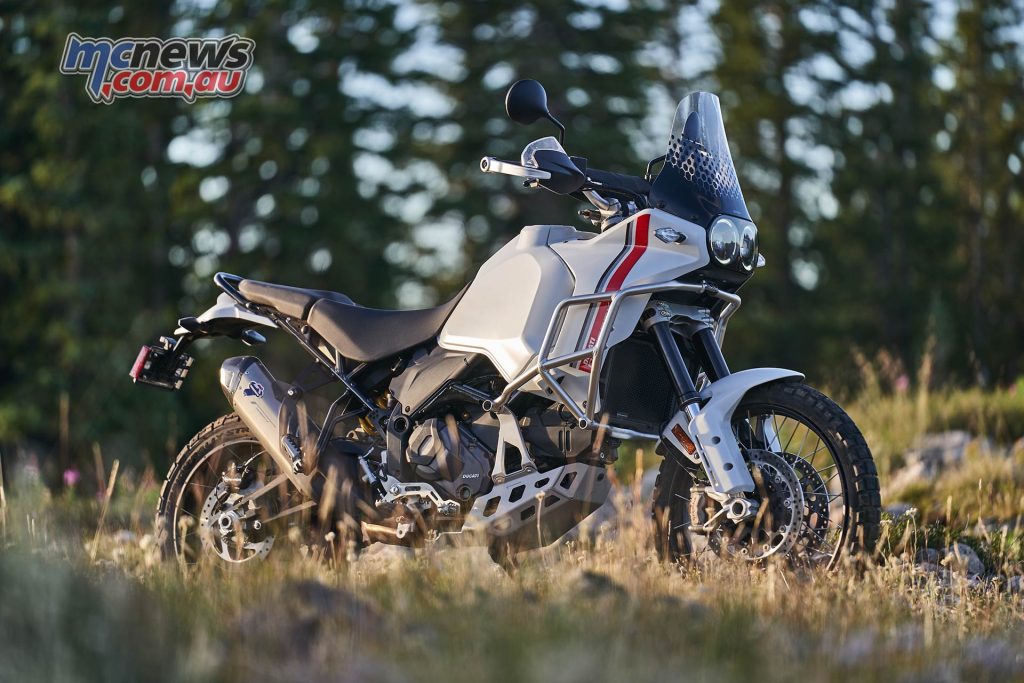
Ducati now joins the likes of class stalwarts KTM, Husqvarna, Yamaha, BMW, Triumph, and new boys Aprilia in creating a sub-1000cc, sub-four cylinder motorcycle whose primary design focus is when the road gets rocky. Ducati’s all-conquering Multistrada V4 (one of my absolute favourite motorcycles available today), was always coined as the four-bikes-in-one bike—capable of respectable off roading but you weren’t going to put it against a KTM 890 Adventure R in a head-to-head shootout…
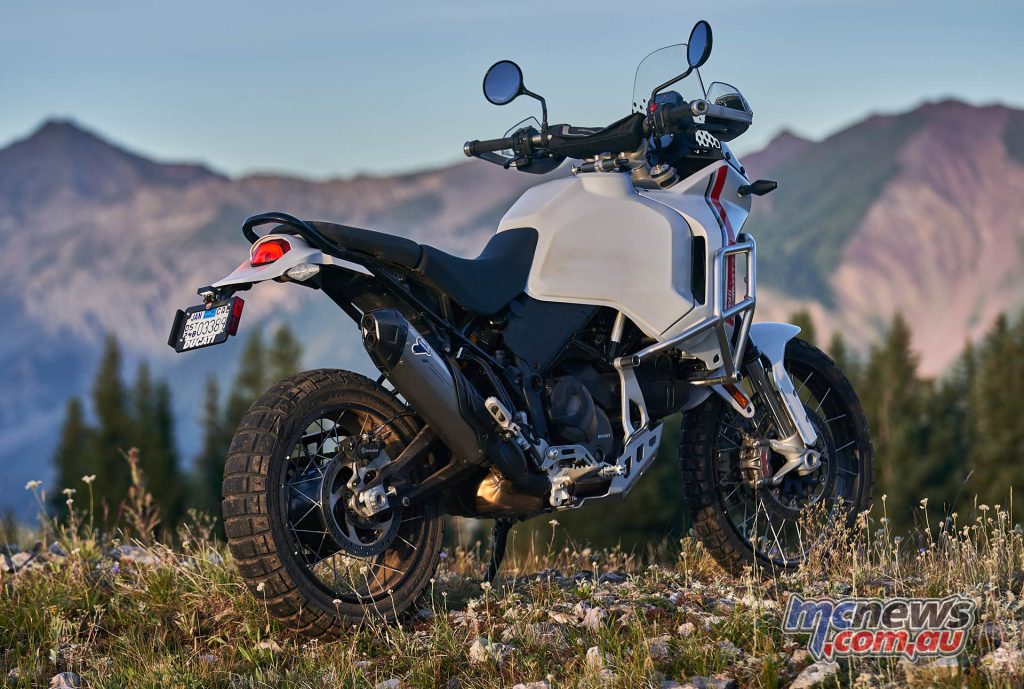
The DesertX is a different proposition. Channelling the colours and aesthetic lines of the immortal Lucky Strike Cagiva Elefant (sic) Paris-Dakar racers of the late 80’s and early 90’s, the DesertX is Ducati’s first real adventure bike, the first to come with a dirt-specific 21-inch front and 18-inch rear wheel set-up.
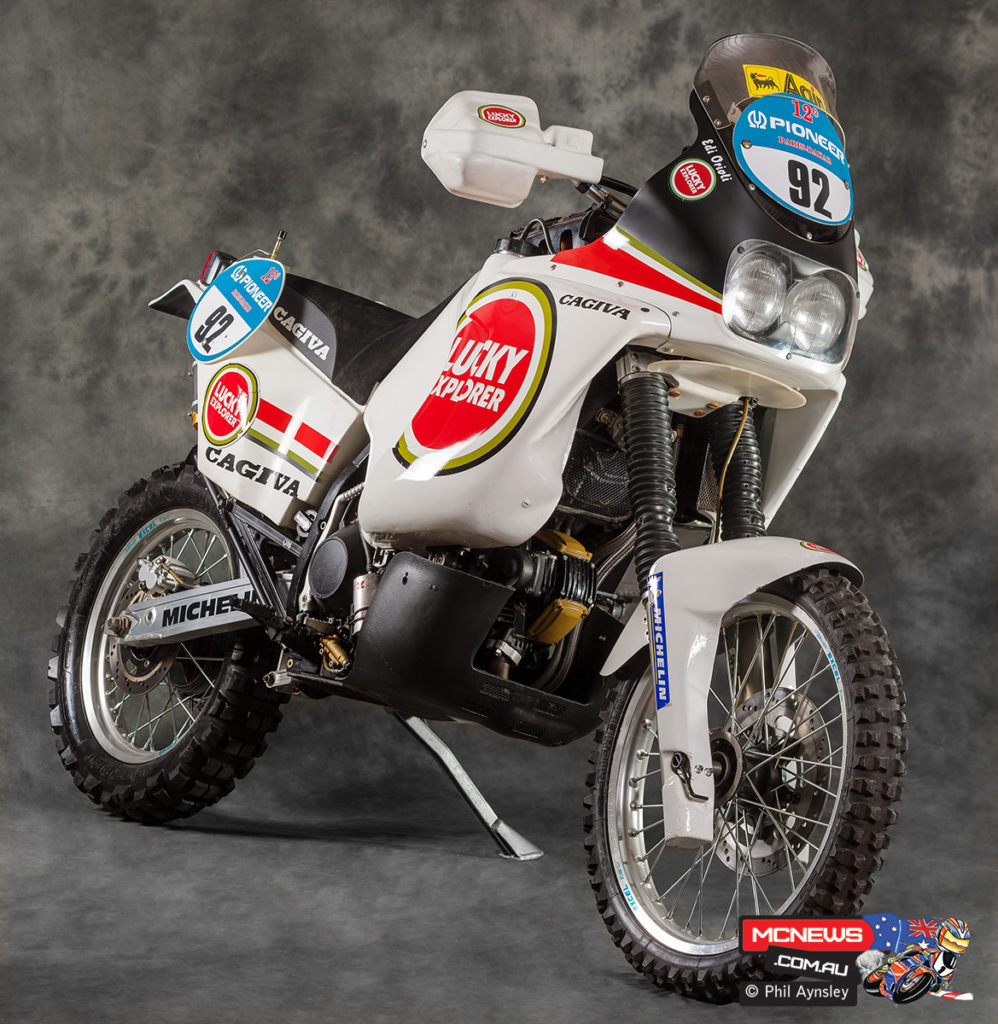
Ducati’s had the motorcycle in development for the best part of five years—at least a couple of years before we saw a dressed-up teaser Scrambler 1100 at EICMA in 2019—and the Italians have left no stone unturned in their efforts to make the very best ADV fist of it they can.
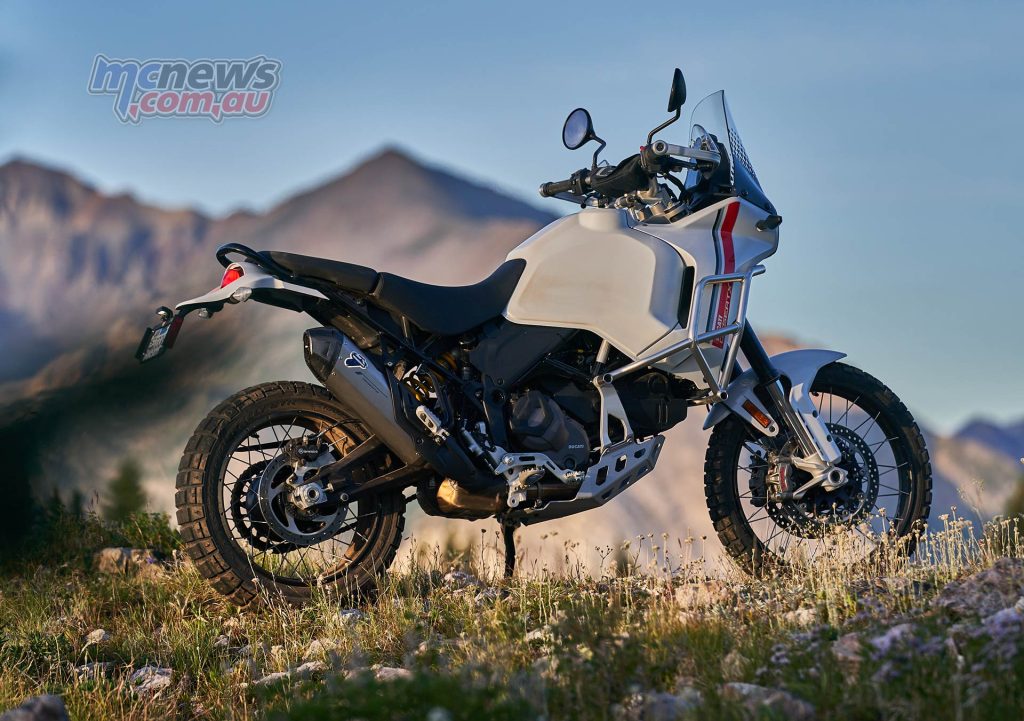
The $24,200 2023 Ducati DesertX uses a version of what is now Ducati’s most widely used motor in the 937cc 11-degree Testastretta, desmodromic L-twin, a motor that’s seen duty in the Multistrada V2, Supersport, Hypermotard and more recently in the Monster (you can read that test here: https://www.mcnews.com.au/2021-ducati-monster-review-motorcycle-tests/).
However, Ducati hasn’t simply shoehorned a streetbike motor into an ADV chassis and called it done. Particular attention has been paid to the gearbox, with a shorter first and second gear ratio (third, fourth and fifth gear are also shorter, just not as much as first and second) so the motor can help the chassis crawl down embankments in much the same fashion as low range does in your 4×4.
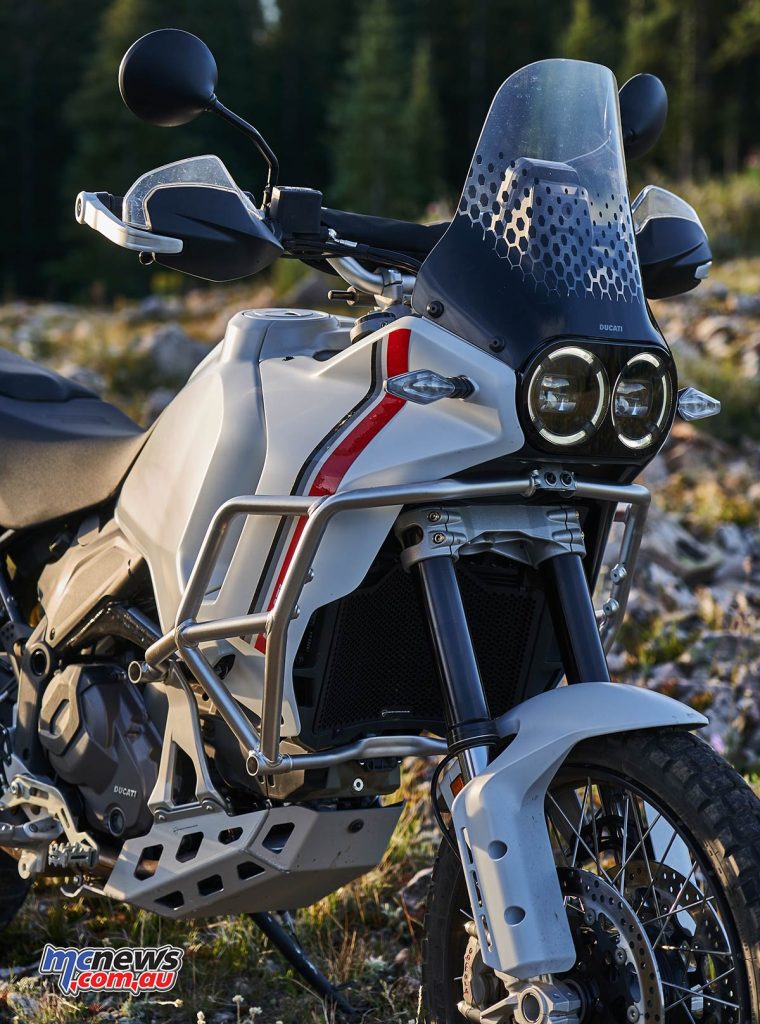
Get the Testastretta up and burning and it’s easy to see its sporting persona shining through. Ducati is claiming 82 kW and 92 Nm of torque for the DesertX, putting it almost on par with the KTM 890 Adventure R (76 kW/98 Nm) and Triumph Tiger 800 XCA (70 kW/78 Nm) and ahead of the smaller capacity Yamaha Tenere 700 (55 kW/67 Nm) and Aprilia Tuareg (60 kW/69 Nm).
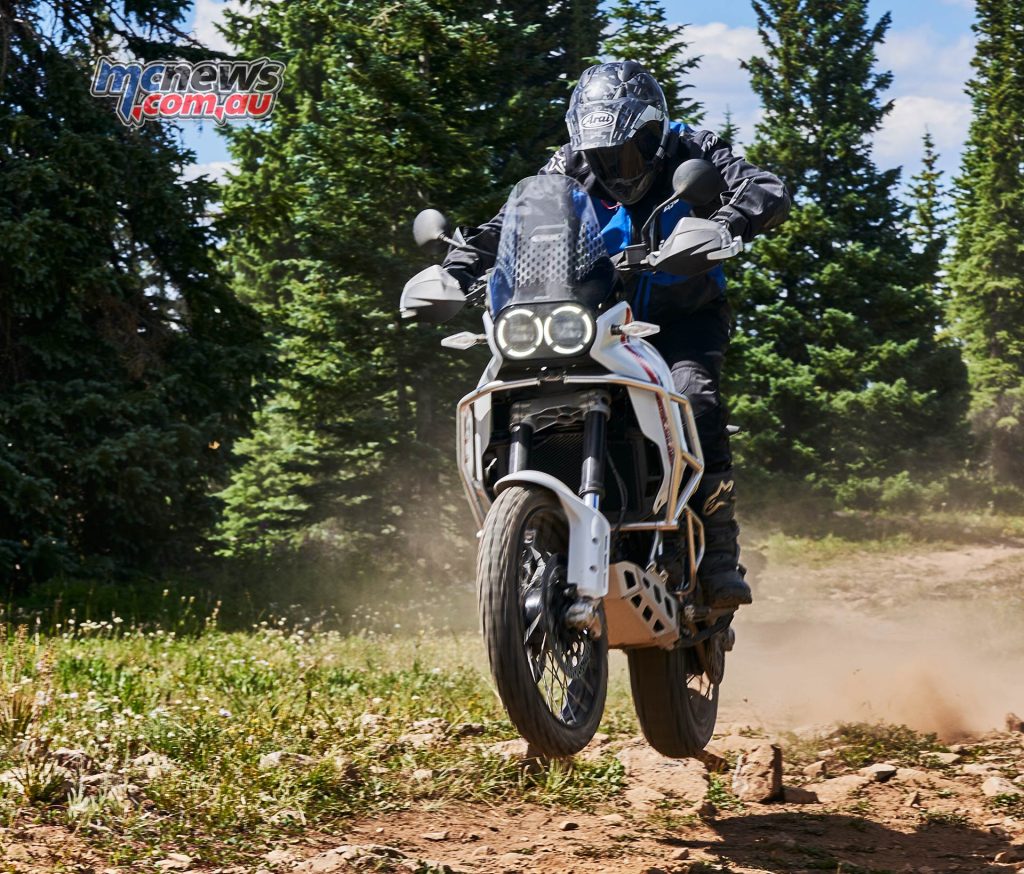
It’ll happily rev out to its 10K rpm redline but keeping the revs below 7000 rpm is where the motor is its happiest. Peak torque is measured at 6500 rpm—rev it harder than that and you may as well be racing Daniel Sanders in the Hattah. This is a big twin, after all, and the Ducati is quite content to stay below 5000 rpm for the majority of off road tasks. Pick a higher gear and let the motor take care of the rest, lugging you along the trail with a deceptively quite exhaust note you primary companion.
The DesertX is very much a case of multiple platforms working in unison to create the ideal riding experience. The revised motor pairs with six riding modes—including an Enduro and Rally mode—four power modes of Full, High, Medium and Low, three-stage Engine Brake Control (EBC), eight-stage Ducati Traction Control (DTC), Ducati Wheelie Control (DWC), Ducati Quick Shift (DQS), cruise control, and three-stage Cornering ABS, all of which is fettled in one way or another by the Bosch six-axis IMU.
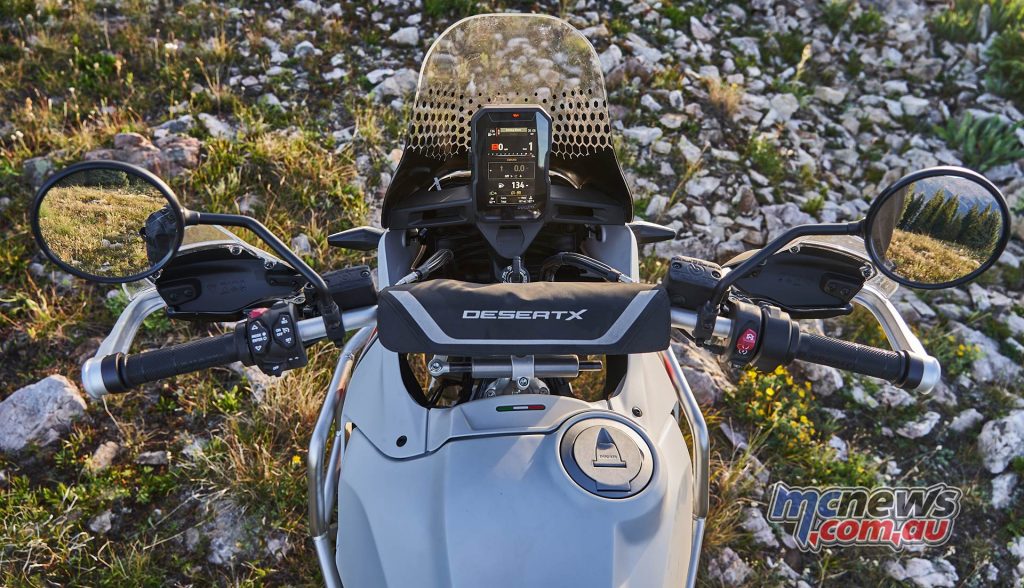
All this information is accessed by a dash that looks like my phone. At five inches tall, it can take a little to get used to the layout, particularly as the current trend seems to be for wider dashes, not taller. Give it a bit of time and you’ll probably come around to it, particularly when you’re doing turn-by-turn navigation as that’s how most people have their phones set up in their cars.
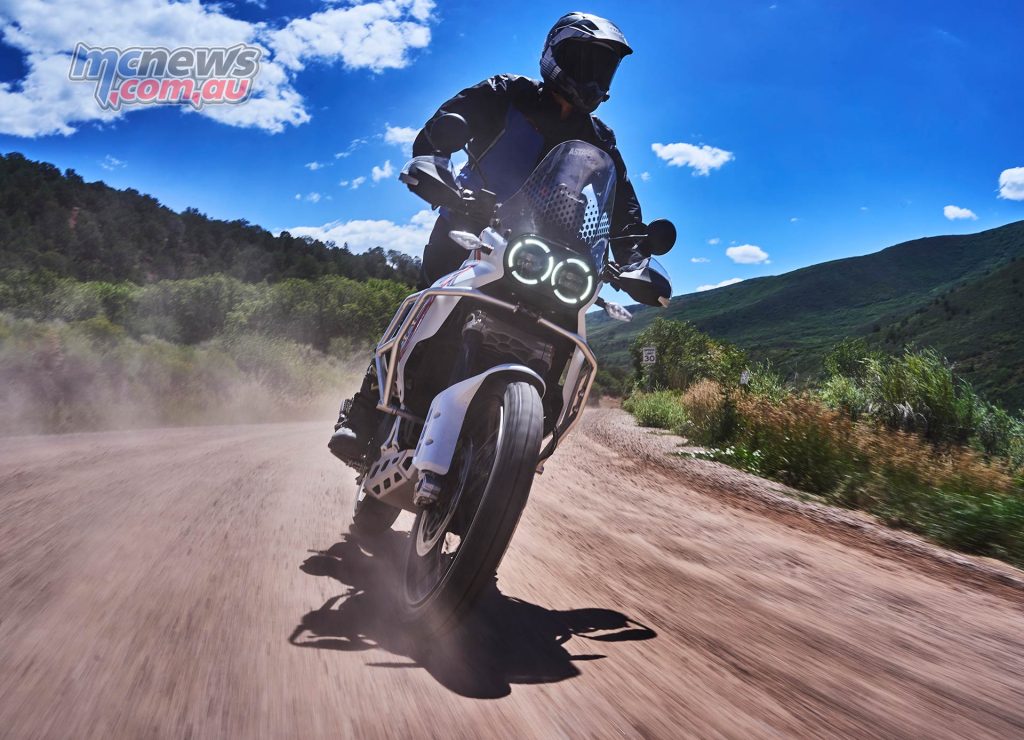
Ducati has been a master of the electronics of late, given their experience with the Panigale V4 range, and they have applied the lessons learned brilliantly with the DesertX. That said, an experienced rider will likely want to save one of the six modes available (this was Rally mode, for me), where there are no electronic interventions. No TC, no wheelie control, full power, full fat. Doing this highlights just how nicely the Ducati engineers have played the game between raw mechanical aggression and finite chassis balance.
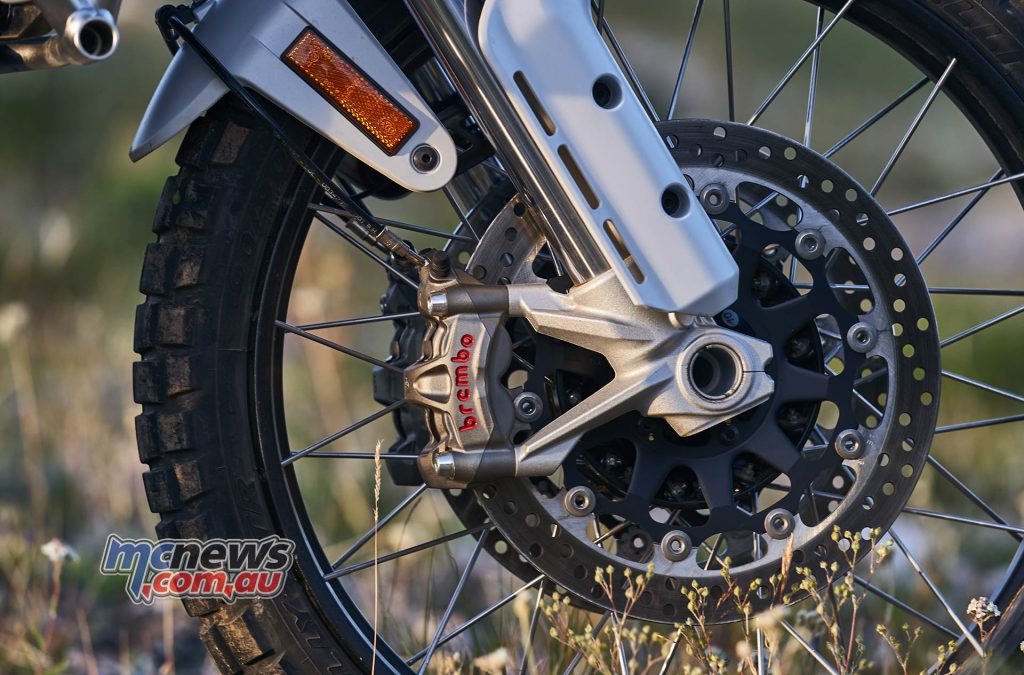
Running chunky 46 mm KYB fully-adjustable forks and shock and four-piston Brembo M50 brake calipers that first saw the light of day on the Kawasaki ZX-10R from half a decade ago, the hardware of the DesertX is top-notch. At 98 kg, fully geared up, I’m a touch heavy for the standard suspension settings and ratcheting up front and rear pre-load, plus turning in on front and rear compression and rebound, gave the chassis are more balanced feeling and allowed me to really attack some of the rocky sections on our test ride in the impossible beauty of Aspen in Colorado, USA.
The standard suspension settings make for quite the spongy streetbike, which is fine if you have no intention of hitting the trails with any real force, but if you want to play out some of those Lucky Strike Cagiva Paris-Dakar dreams you’ve been having, you’ll want to break out the spanners and flat blade.
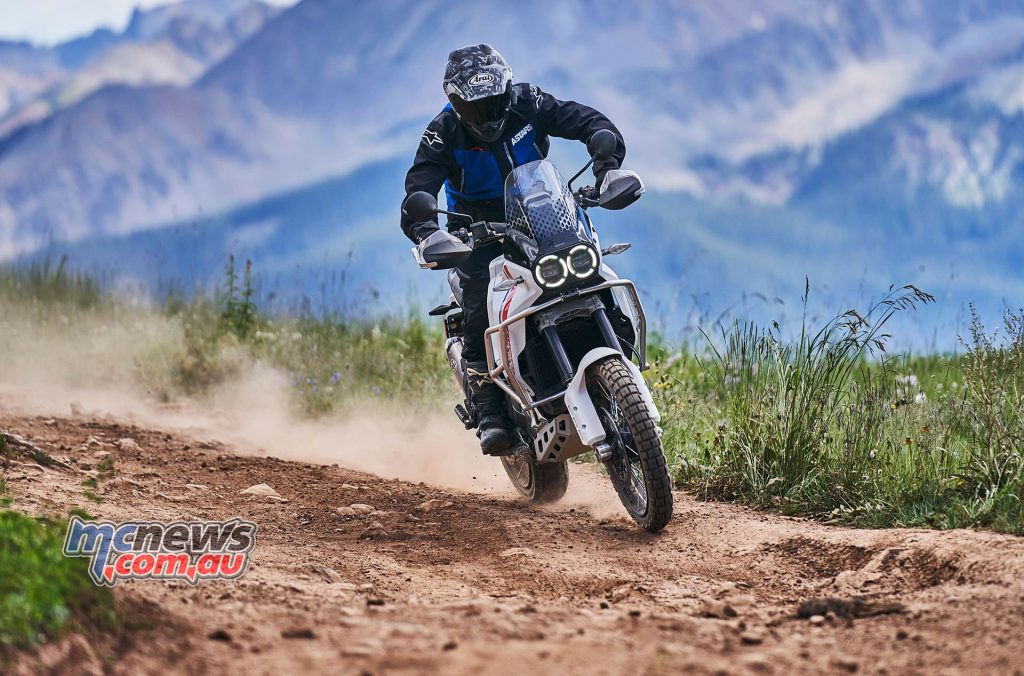
While still a very large motorcycle, tipping the scales at 223 kg of kerb weight (that’s including all fluids and a 90 percent full tank of fuel to you and me) with a seat height of 875 mm, the Ducati is far from an intimidating proposition if you have even limited experience in ADV riding.
The all-important rider triangle of handlebar, seat and foot-peg position is best described as roomy. High-mount handlebars encourage stand-up riding, allowing the tubeless 21-inch front and 18-inch rear wheels laced with Pirelli Scorpion Rally STR rubber to soak up the hopefully many corrugations the rocky road beneath the chassis throws your way.
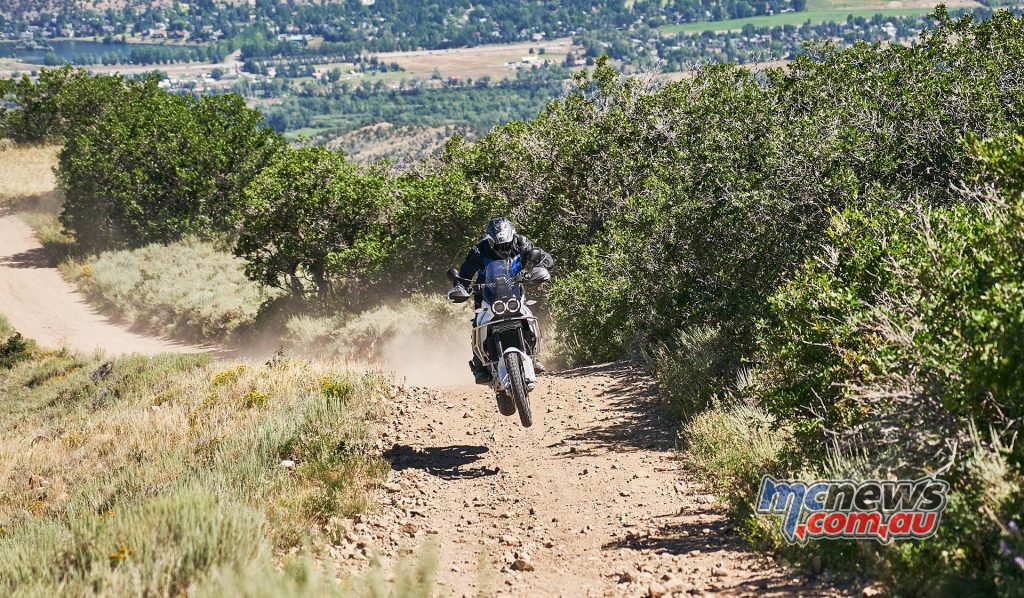
The ride position feels like a cross between the Yamaha Tenere 700 and Triumph Tiger XCA 800 and the position and shape of the tank is a bit old-school when you compare it to the low-slung fuel tank of the KTM 890 Adventure R—but it feels like a pee-wee compared to something like a BMW R 1250 GSA!
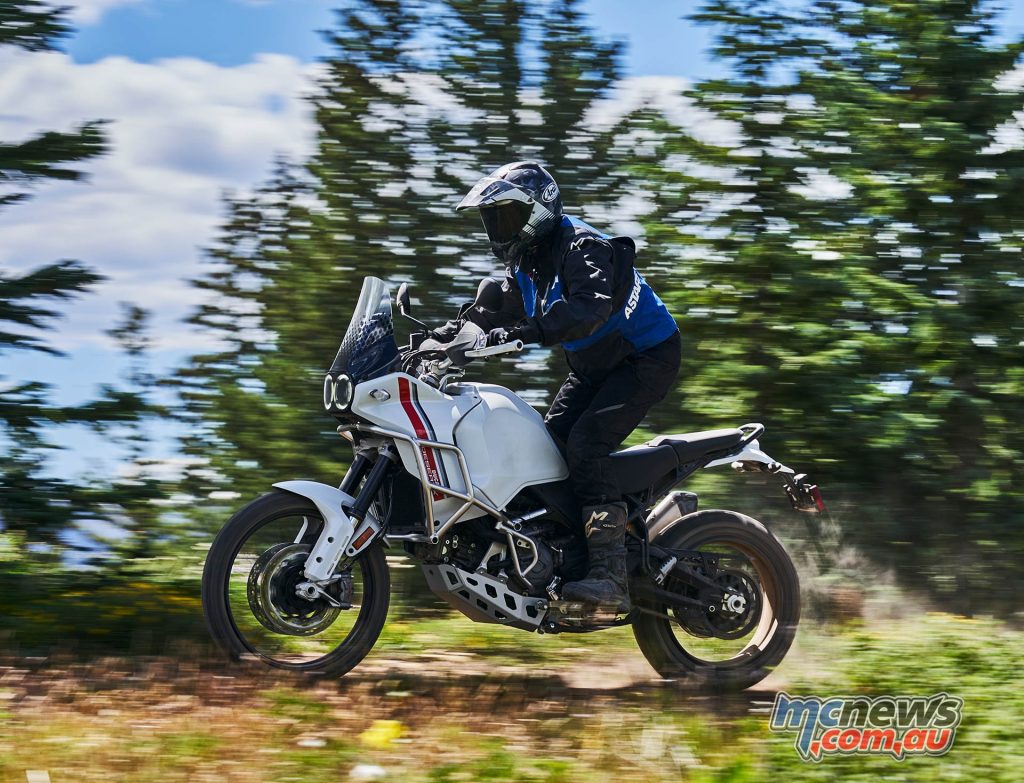
The two-person seat doubles up as a hitching point for the optional auxiliary gas tank that comes part of the accessory catalogue developed in-house by Ducati. The standard tank fills up to 21 litres, with auxiliary tank netting an extra eight litres. The result is a bike with far less weight than something like a GSA, but only seven litres less of fuel tank capacity—trust me, you’ll want to stop and fill up long before you run out of petrol… It is not quite a GS when it comes to day long mile eating comfort.
The tank itself clips onto the back of the passenger seat body-work and is enabled when fuel reaches a certain level, at which point you get a light on the dash telling you it’s time to switch via a switch on the handlebar. However, rather than just drip feed fuel into the fuel rail, the auxiliary tank’s payload is transferred in one hit back to the main tank, the benefit being the weight distribution isn’t all mangled with eight litres of fuel at the back of the bike and none at the front. And, you don’t have to stop while doing the transfer. Neat.
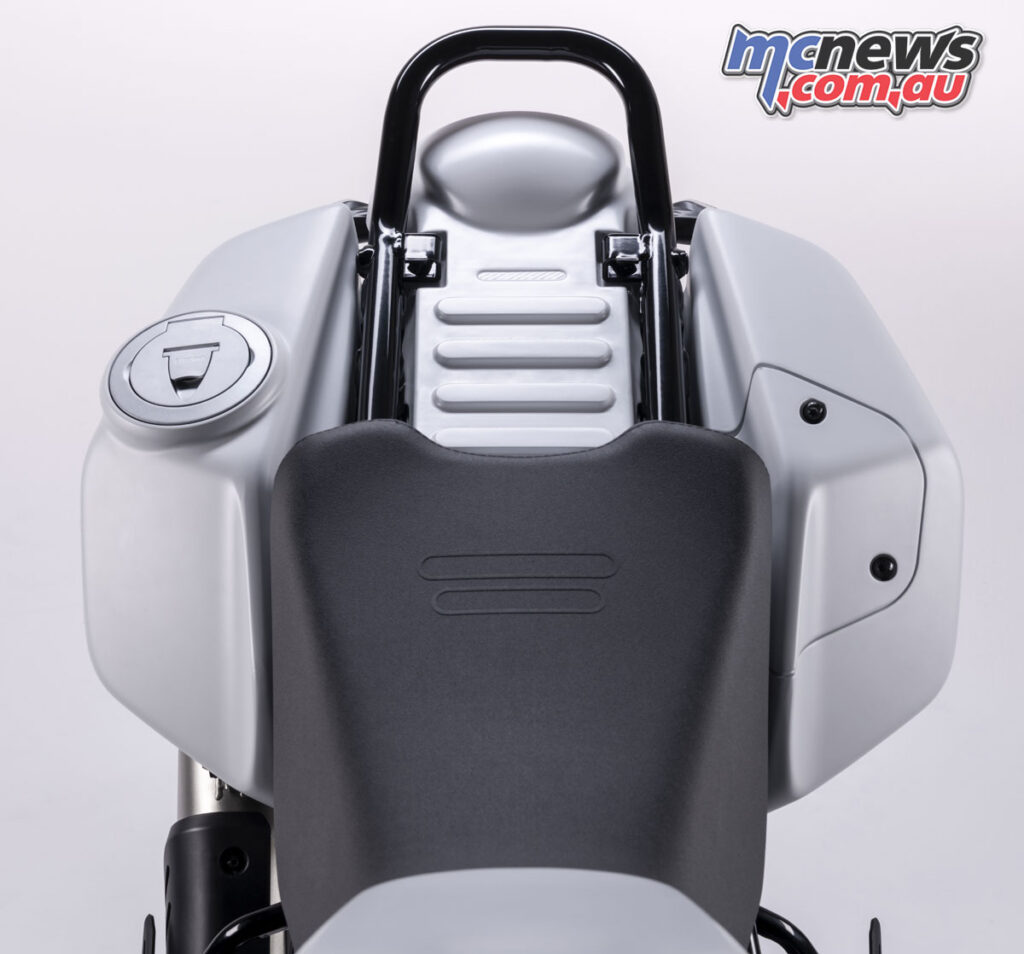
And if I really think about it, that’s probably the best adjective I can use when describing the Ducati DesertX. It’s a very neat motorcycle. Cleverly thought out, classily doffing the cap to the heroic Cagivas of yesteryear while being a thoroughly modern motorcycle underneath, I’ll admit to being pleasantly surprised at its capabilities, especially for a first-time model.
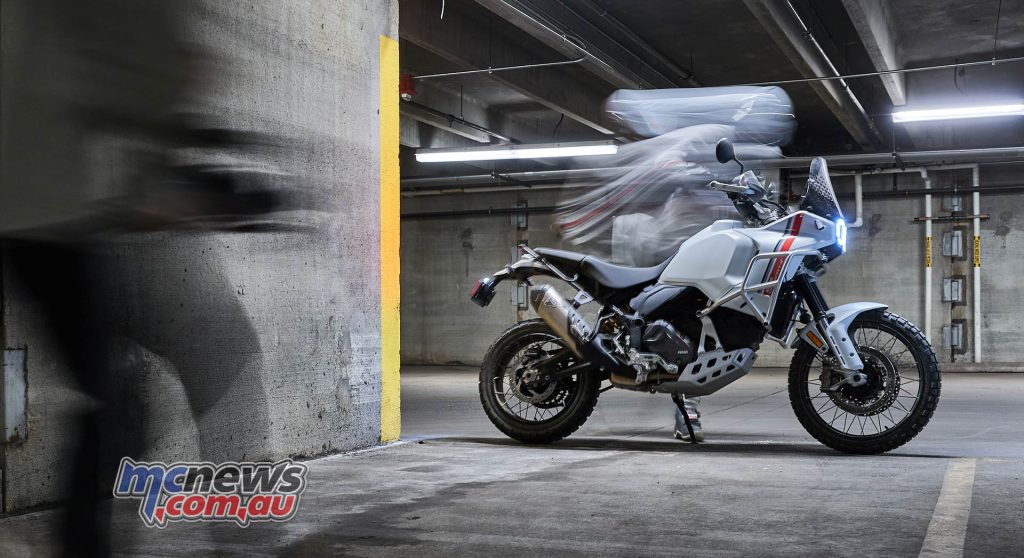
The good thing about the DesertX is you’re only buying one bike. Unlike so many others on the market there’s no electronic paywalls you need to break through to gain higher levels of performance. Yes, the DesertX’s price reflects that, but I’ve hardly seen a GS out there that isn’t optioned to the hills, making the sticker price somewhat redundant.
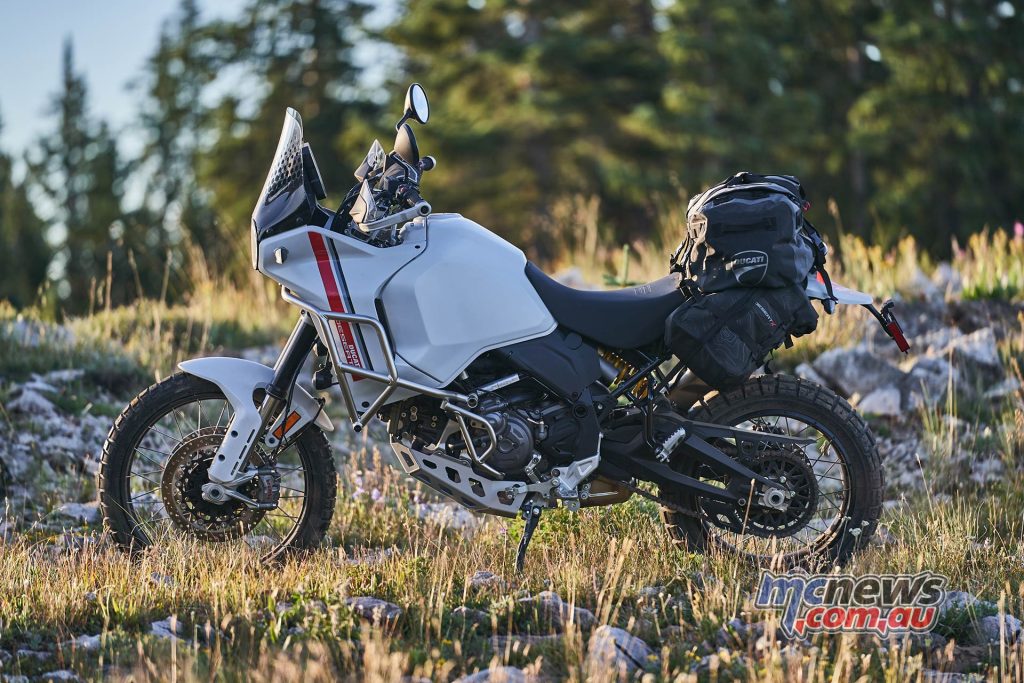
Ducati has done a very good job with the DesertX. It’s got the right motor for the job, the suspension, while being a little plush in standard settings, is fully adjustable and thus you’re able to get around those issues, and there’s every electronic bell and whistle you could ever need. It’s a neat adventure motorcycle.
Ducati DesertX Specifications
| 2022 Ducati DesertX Specifications | |
| ENGINE | Ducati Testastretta 11°, L-Twin cylinders, Desmodromic valvetrain, 4 valves per cylinder, liquid cooled |
| DISPLACEMENT | 937 cc |
| BORE X STROKE | 94 x 67.5 mm |
| COMPRESSION RATIO | 13.3:1 |
| POWER | 110 hp (81 kW) @ 9,250 rpm |
| TORQUE | 92 Nm (68 lb-ft, 9.4 kgm) @ 6,500 rpm |
| FUEL INJECTION | Bosch electronic fuel injection system, Ø53 mm throttle bodies with ride-by-wire system |
| EXHAUST | Stainless steel single mufler, catalytic converter and 2 lambda probes |
| Transmission | |
| GEARBOX | 6 speeds |
| PRIMARY DRIVE | Straight cut gears, ratio 1.85 : 1 |
| RATIO | 1=38/14, 2=31/17, 28=28/20, 4=26/22, 5=24/23, 6=23/25 |
| FINAL DRIVE | Chain, front sprocket Z15, rear sprocket Z49 |
| CLUTCH | Slipper and self-servo wet multiplate clutch with hydraulic control |
| Chassis | |
| FRAME | Tubular steel trellis frame |
| FRONT SUSPENSION | KYB Ø 46 mm upside-down fork, fully adjustable, 230 mm |
| WHEELS | Cross-spoked, tubeless, 2.15 x 21in, 4.50 x 18in |
| REAR SUSPENSION | KYB monoshock, fully adjustable, remote preload adjustment, aluminium double-sided swingarm, 220 mm travel |
| TYRES | Pirelli Scorpion Rally STR, 90/90 – 21 M/C 54V M+S TL (A), 150/70 R18 M/C 70V M+S TL, |
| FRONT BRAKE | 2 x Ø 320 mm aluminum flange semi-floating discs, Radial mount Brembo monobloc 4-pistons calipers, Bosch Cornering |
| REAR BRAKE | Ø 265 mm disc, Brembo floating 2 pistons caliper, Bosch |
| INSTRUMENTATION | 5’’ TFT colour display |
| Dimensions & Weights | |
| DRY WEIGHT | 202 kg (445 lb) |
| KERB WEIGHT* | 223 kg (492 lb) |
| SEAT HEIGHT | 875 mm (34.4 in) |
| WHEELBASE | 1608 mm |
| RAKE | 27,6° |
| TRAIL | 122 mm |
| FUEL TANK CAPACITY | 21 l (5.54 US gal) |
| NUMBER OF SEATS | 2 |
| Equipment | |
| SAFETY EQUIPMENT | Ducati Safety Pack (Cornering ABS, Ducati Traction Control), Riding Modes, Power Modes, Ducati Wheelie Control (DWC), Engine Brake Control (EBC), Ducati Quick Shift up/down (DQS), |
| STANDARD EQUIPMENT | Cruise control, full LED lighting system, DRL, Ducati brake light, (DBL), USB power socket, 12V socket, self canceling turn, indicators, Steering damper |
| READY FOR | Ducati Multimedia System (DMS), Antitheft system, Turn by turn navigation via app, fog lights, heated grips, auxiliary fuel tank |
| Warranty & Maintenance | |
| WARRANTY | 24 month, Unlimited mileage |
| MAINTENANCE SERVICE INTERVALS | 15,000 km (9,000 miles) / 24 months |
| VALVE CLEARANCE CHECK | 30,000 km (18,000 miles) |
| Emissions & Consumption | |
| STANDARD | Euro 5 |
| CO2 EMISSIONS | 133 g/km |
| CONSUMPTION | 5.6 l/100 km |
| RRP | $24,200 Ride Away |
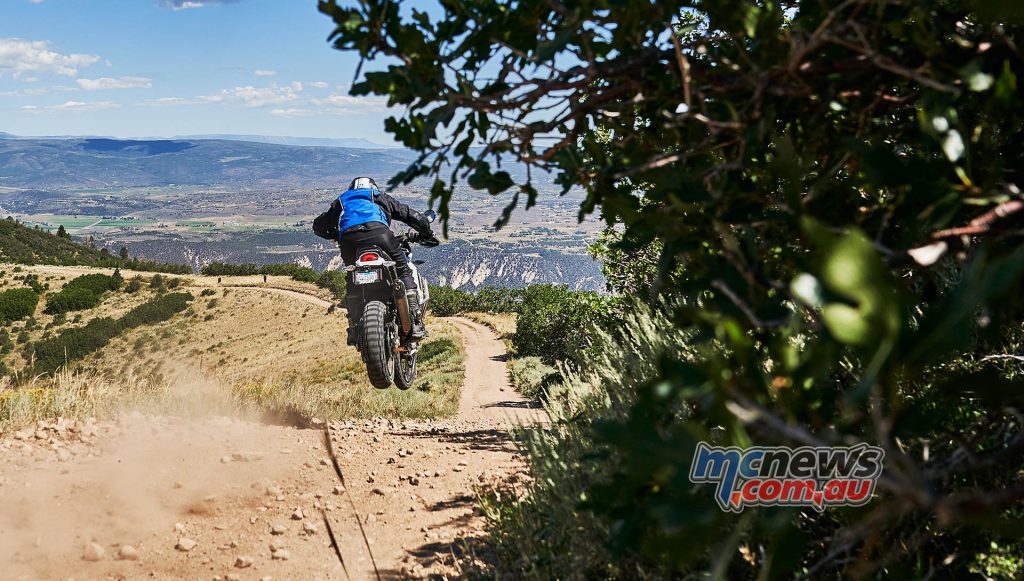
Photography Grego Halenda
See the Ducati Australia website for more information.



